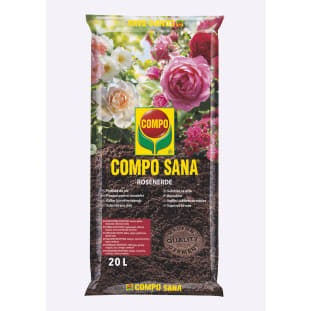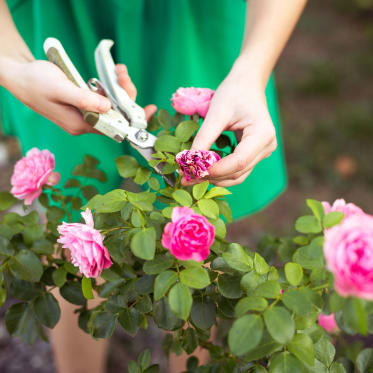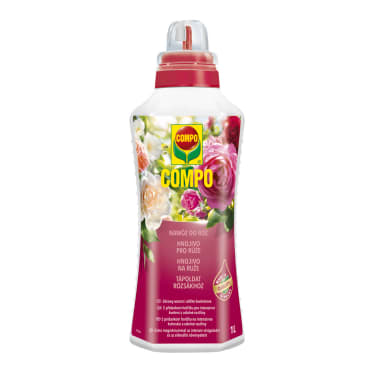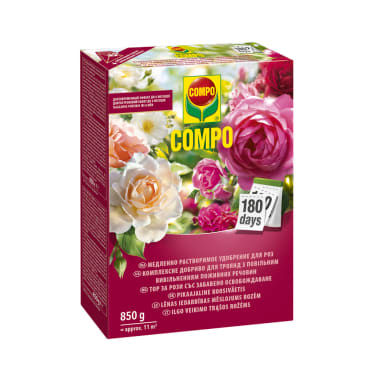Frequent search terms
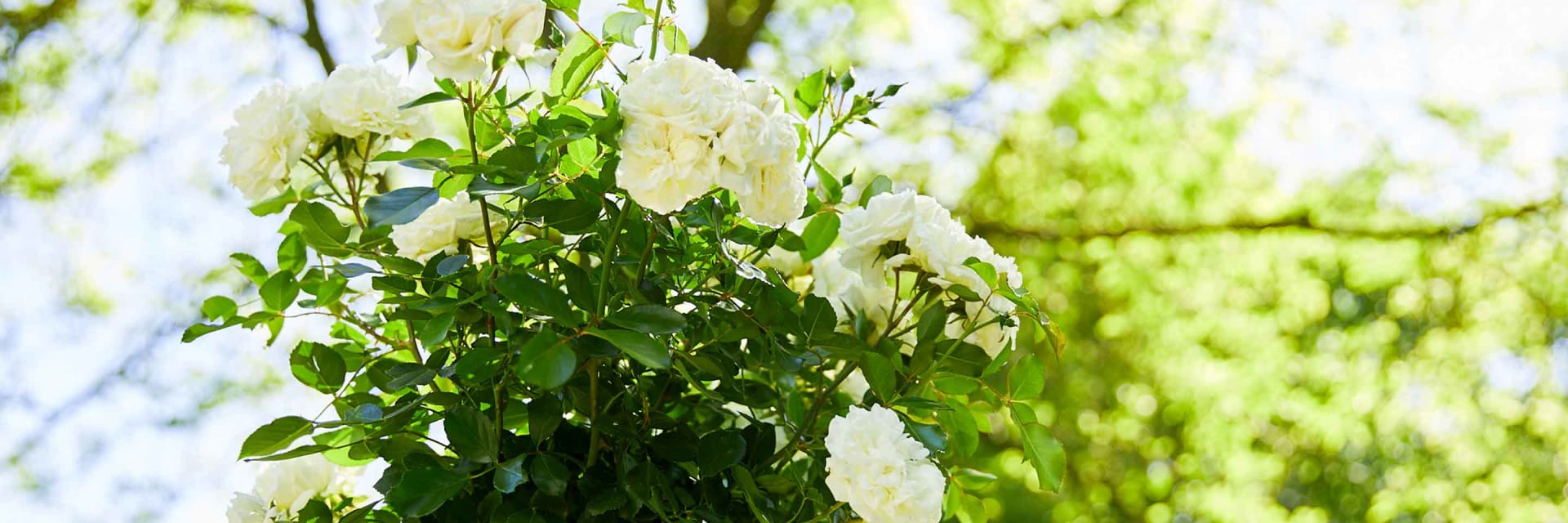
- COMPO
- Guide
- Plant Care
- Garden
- Roses
- Repotting roses
Repotting roses
Roses are a truly classic plant and can be found in numerous gardens. But even if space is limited, you don't need to do without this flowering shrub. Some roses can be cultivated in containers with no issues at all! There's a key extra care step to bear in mind, though: repotting. We reveal why pot roses regularly need a new home, when's the right time and how you can correctly repot your rose.

How can I tell if I need to repot my rose?
Roses' roots grow very quickly. Generally, they run out of room in their old container after two or three years. For them to stay alive, they need to be given fresh soil and a larger pot at regular intervals. You can see that their space has got too small if the roots are already lifting out of the pot or are growing through the drainage hole at the bottom. Another indication that their home isn't big enough is that the root system is so dense that water can no longer be properly absorbed. Lastly, stunted growth or signs of deficiency can also indicate that roses need to be repotted. If this happens, the pot may well be big enough, but the substrate may be so exhausted that it's led to signs of deficiency. In this instance, simply swap the old substrate for fresh, nutrient-rich soil.
Repotting roses – when's the best time?
The best time to repot roses is from mid-January onwards, as these flowering plants gradually start to grow again when the mild temperatures return in the spring. While you can repot roses in the summer, too, you should cut them back heavily to start with. If you provide them with enough water, they'll quickly start to form shoots again afterwards. Once this flowering shrub has lost its leaves in autumn, it enters a dormant state. In other words, the plant stops growing until the next spring. Generally, roses cast off their petals as a result of the move – another reason to repot them in spring before they start forming the first shoots.
Step-by-step guide
Repotting roses

1
Choosing the right container
The perfect home for your roses must have drainage holes to allow excess water to run off freely. Otherwise, you can end up with standing water and the roots of the flowering shrub can begin to rot. Besides this, you can put pumice or old shards of clay in the pot to serve as drainage.

2
Fill the pot with soil
Roses need fresh soil for their new home and a nutrient-rich, humus-rich special soil like 'COMPO SANA® Rosenerde' rose soil is ideal. The minerals it contains and its proportion of humus encourage a loose and airy structure. The nutrients in it ensure your rose receives a balanced supply of all the key main and micronutrients. Thanks to its slow-release fertiliser effect, your rose won't need any additional nutrients for the next three months after it's been repotted.

3
Prepare the rose
As soon as roses are on the agenda, one thing is hugely important, wear gloves! This means you can carefully lift the flowering plant out of its old pot without damaging its roots. After that, treat your rose's root ball to a little dip – keep the roots under the water until air bubbles stop rising. If you notice damaged or even rotten roots, snip them off with pruning shears.

4
Insert the rose and press it in
Now it's time to put this flowering shrub into its container – be careful the roots don't snap off as you do so. Then fill the gaps with more rose soil until there's about two centimetres left at the top of the pot. This gives you room to water the plant. If you have a grafted rose, do make sure that the grafted union is three to five centimetres under the soil, as the plant is particularly vulnerable to frost at this point. You can identify the graft union by means of the small lump. Then press the rose in slightly to close all the gaps in the soil.
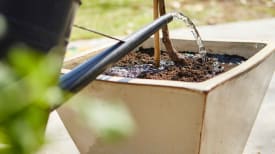
5
Water and care for your rose
Finally, give the rose a good soaking and ensure you water it well afterwards, too. After three months, you can fertilise your container rose with a special rose fertiliser. This encourages flower formation and stimulates root growth, thereby ensuring your plant develops well.
Three tips for repotting roses
- While young roses cope relatively well with repotting due to their weakly pronounced root system, older ones usually struggle more with changing pots. A cautious approach is advised to prevent them from suffering any damage and so you can continue enjoying this beautiful flowering shrub.
- Is your container rose a particularly large variety? To make it easier to repot, you can use a rip-proof piece of non-woven fabric. Position the non-woven fabric in the pot so there are a couple of centimetres left at the top, then fill with soil. When the rose needs to be repotted, grab the ends of the fabric, ideally with the help of an additional person, and pull the rose and its roots out of the container.
- Need to repot your rose but there's no space on your balcony or patio for a larger pot? In this case, you can slightly shorten the root ball after you've freed it from the soil. To do so, cut back the thick roots and reduce the shoots to a length of around 10 centimetres. You can then put the rose back into its old pot, filled with fresh soil.
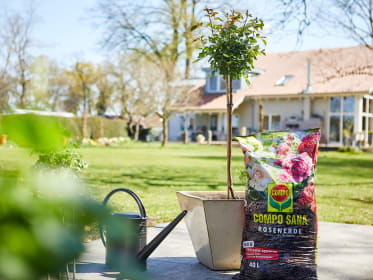
These roses can be planted in pots or containers
Whether a rose is well-suited to life as a container plant depends on the shape it grows. Those that grow runners or tall shrub roses will get too big for a container. Having said that, roses in containers often only reach one third or half of their maximum height. For instance, small shrub roses or bed roses are particularly popular as pot roses. These roses can be bred as a tall stem, making them ideal for a container. Find out even more about the array of rose varieties here. By the way, you can add other plants to the same container as your rose to serve as undergrowth here, too.
Here are our favourite pot roses:
| Rose variety | Flower colour | Natural height |
|---|---|---|
'Bonica' | Pink flowers | 60 to 80 centimetres |
'Rosarium Uetersen' | Bright pink flowers | 150 to 200 centimetres |
'Margaret Merril' | White flowers | 60 to 80 centimetres |
'Winchester Cathedral' | White flowers | 80 to 150 centimetres |
'Golden Celebration' | Golden-yellow flowers | 100 to 150 centimetres |
'English Garden' | Yellow flowers | 70 to 90 centimetres |
More on roses
Suitable products for rose care

